Art exam 1
1/180
There's no tags or description
Looks like no tags are added yet.
Name | Mastery | Learn | Test | Matching | Spaced |
|---|
No study sessions yet.
181 Terms
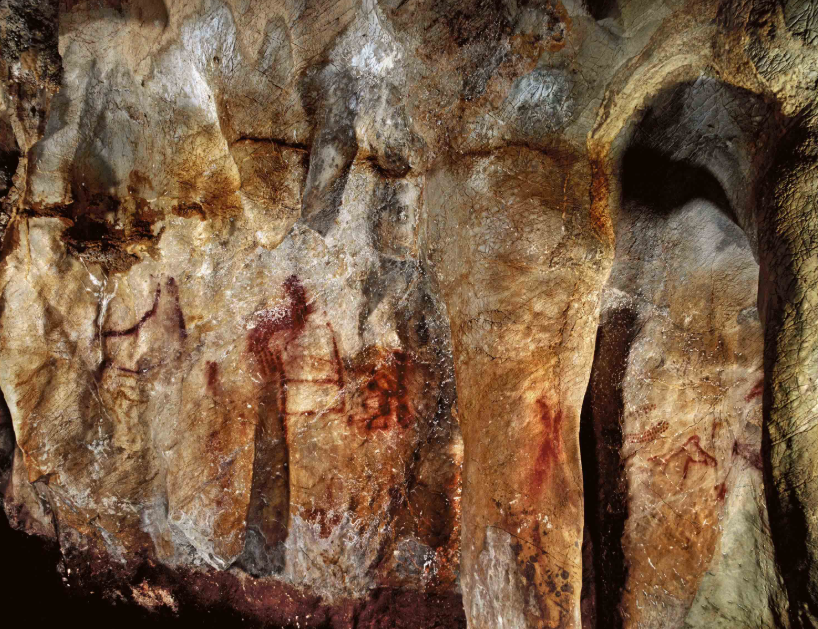
La Pasiega Cave, Spain
c. 65,000 BCE.
Paleolithic (Neanderthal peoples)
Earliest known Neanderthal cave paintings
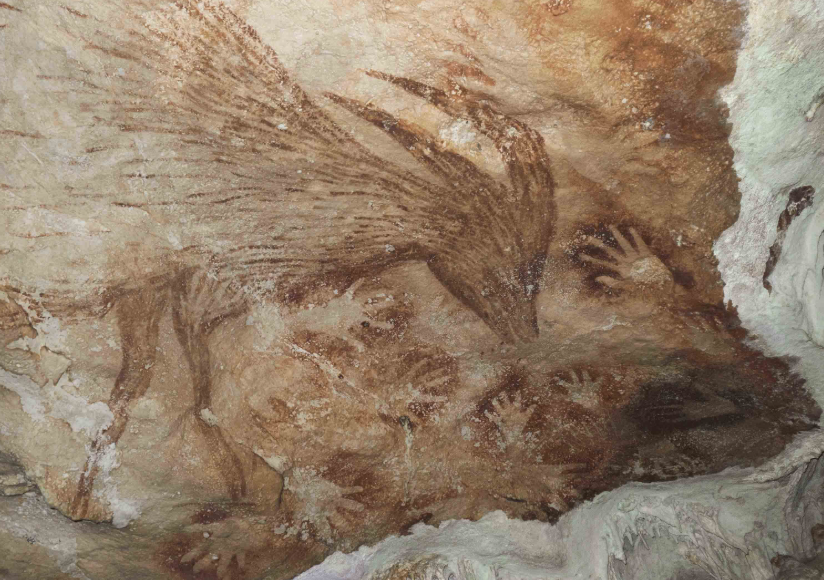
Cave with animal and handprints, Indonesia
c. 37,000–34,000 BCE.
Paleolithic
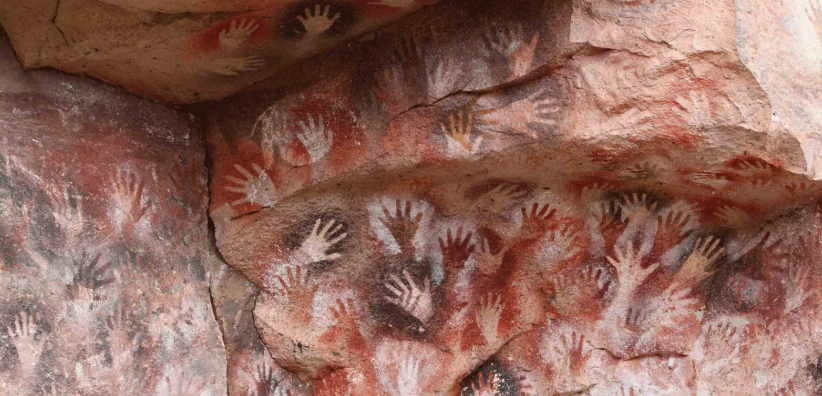
Cave of the Hands, Argentina
c. 11,000–7000 BCE.
Paleolithic

Hall of Bulls, Lascaux Cave, France
c. 15,000 BCE.
Paleolithic
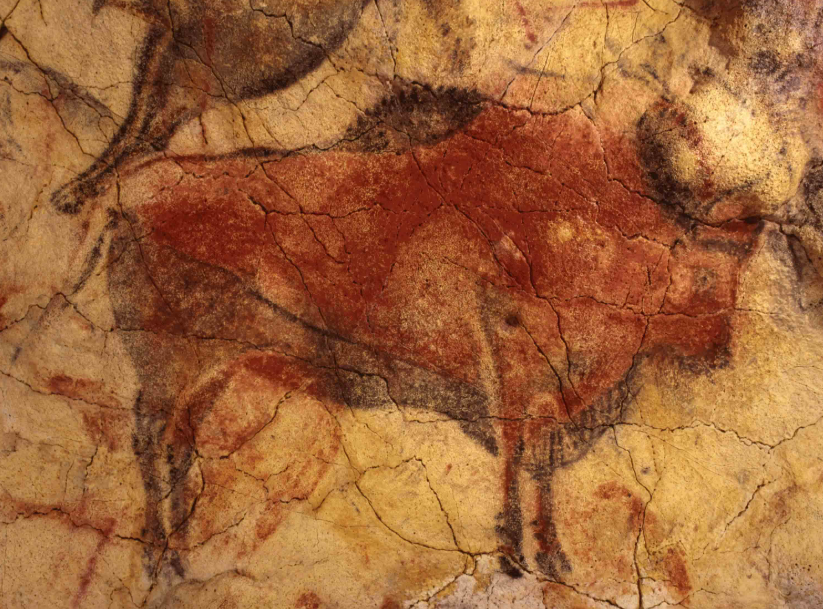
Steppe-Bison, Altamira Cave, Spain
c. 12,500 BCE.
Paleolithic
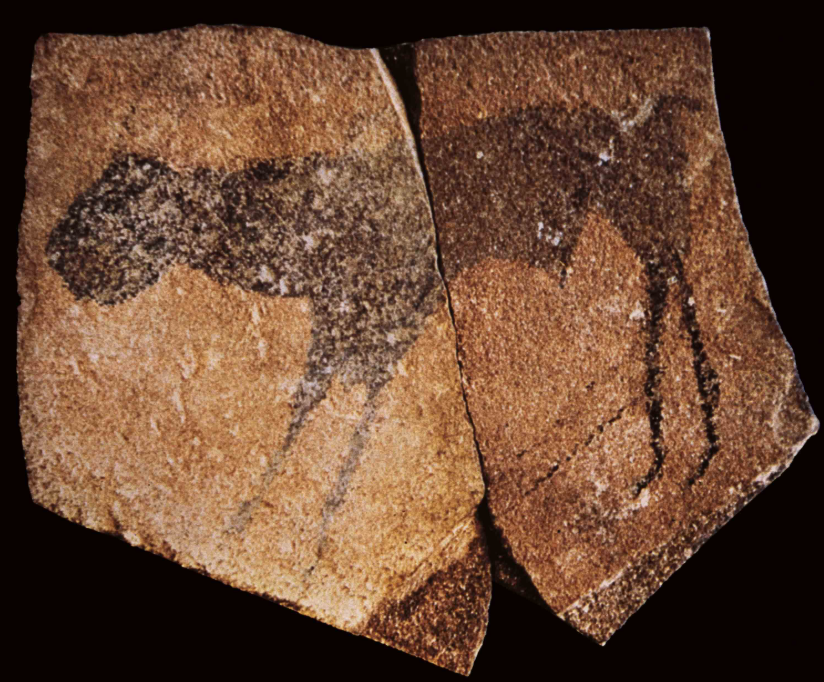
Painted rock fragments from Apollo 11 Cave, Namibia, Africa, 25,500–23,500 BCE.
Paleolithic
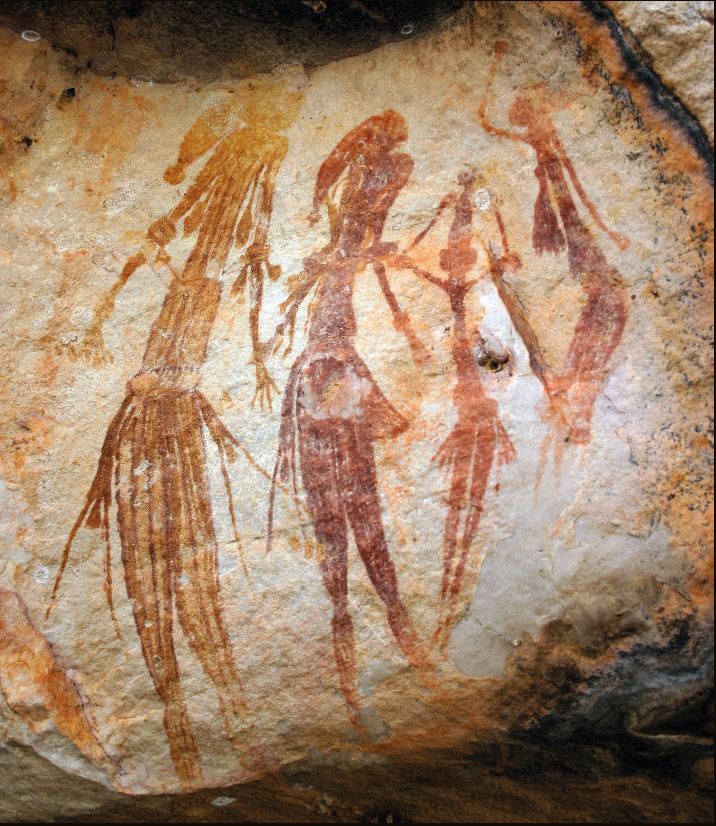
Gwion Gwion figures, Australia
c. 20,000 BCE.
Paleolithic
Spirit ancestor
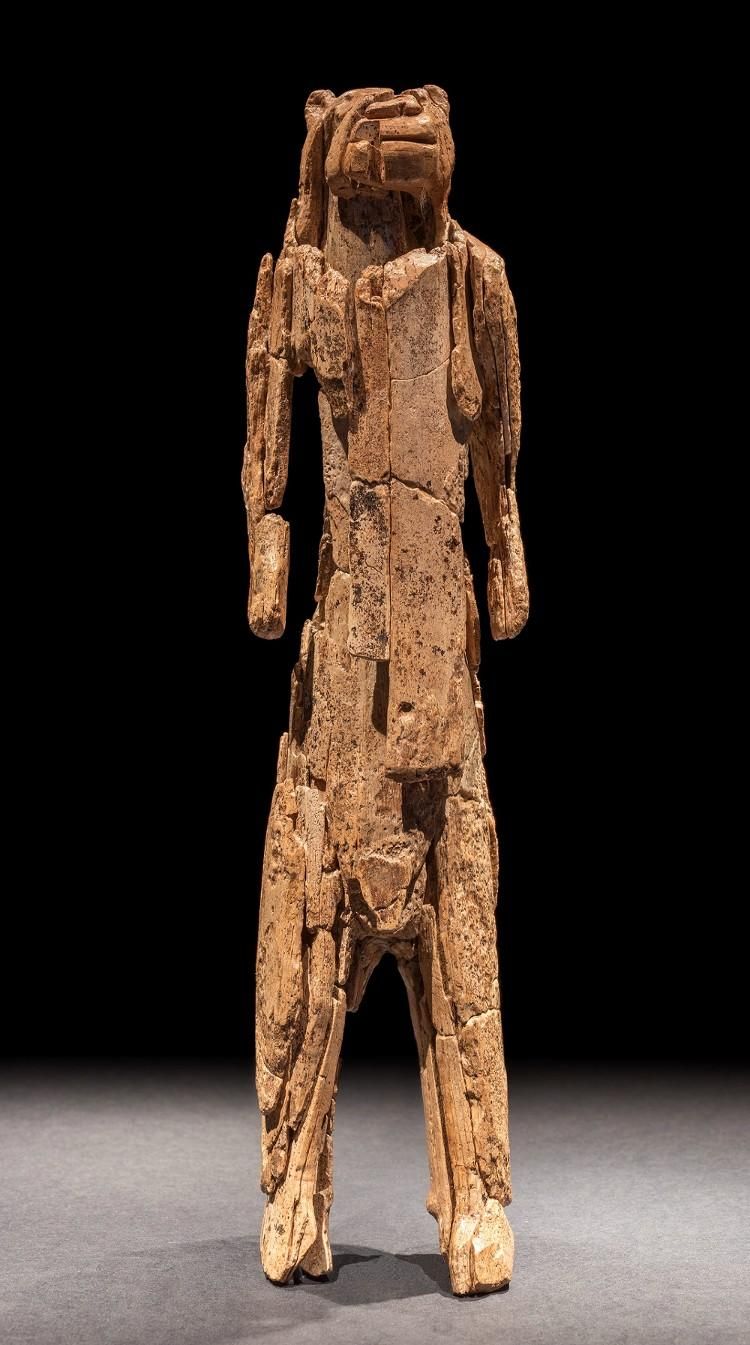
Lion-human figurine
c. 40,000–35,000 BCE.
Paleolithic
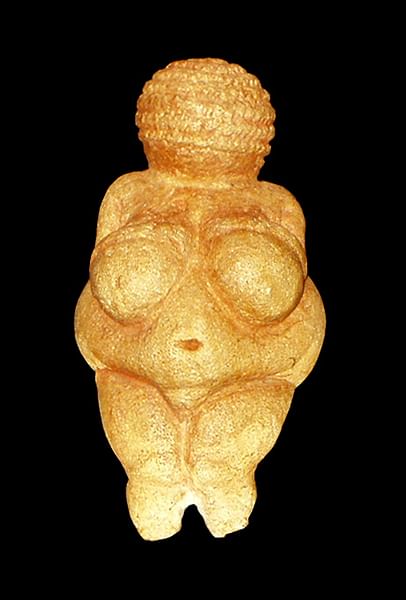
Woman of Willendorf
24,000–22,000 BCE.
Paleolithic
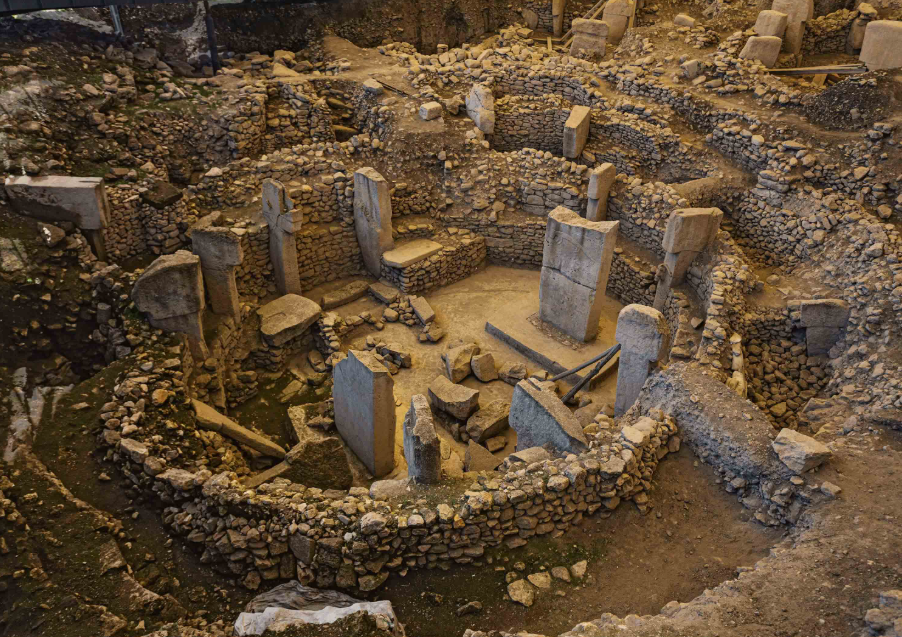
Göbekli Tepe semi-subterranean structure, Turkey
c. 9000 BCE.
Neolithic
Post and lintel, stone
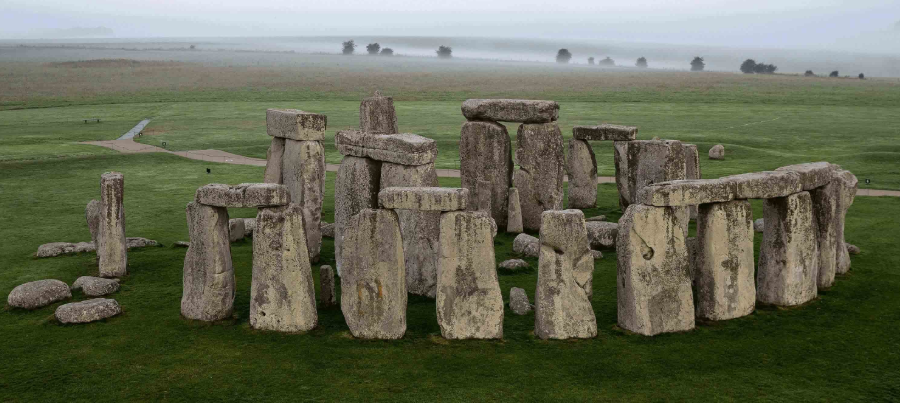
Stonehenge, England
2900–1500 BCE.
Neolithic
Megalithic architecture
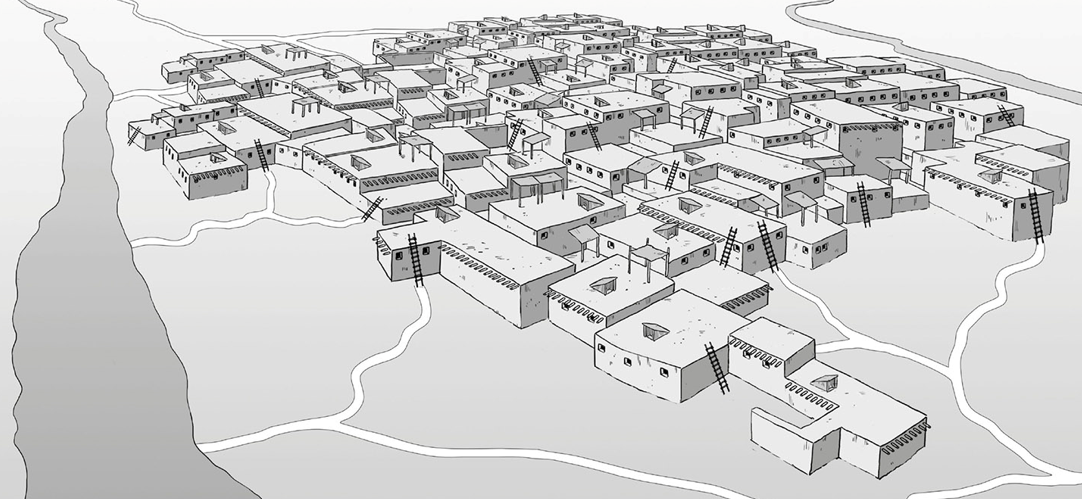
Çatalhöyük settlement (reconstruction drawing), Turkey.
Neolithic
Settled community, in adobe
Ocher
Hand stencil
Figurative
Radiocarbon dating
Painterly
Incised
Megalith
Low relief
Cyclopean masonry
Corbeling
Henge
Post-and-lintel
Trilithons
Adobe
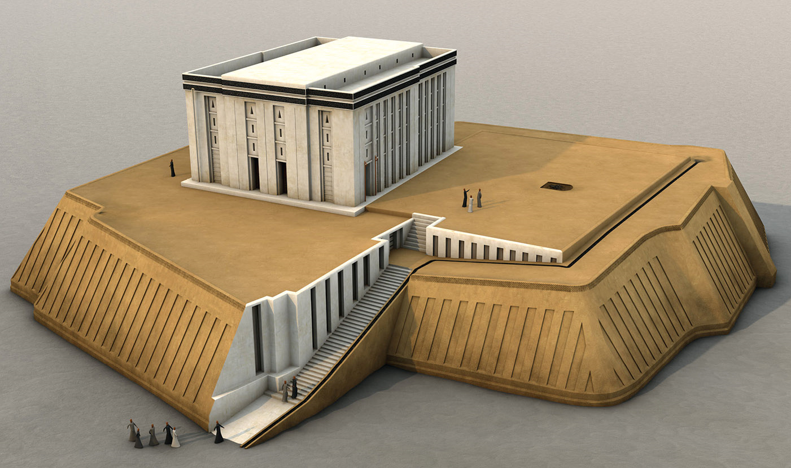
Temple of Anu at Uruk, Iraq
“White Temple”
c. 3300 BCE
Whitewashed temple with niches
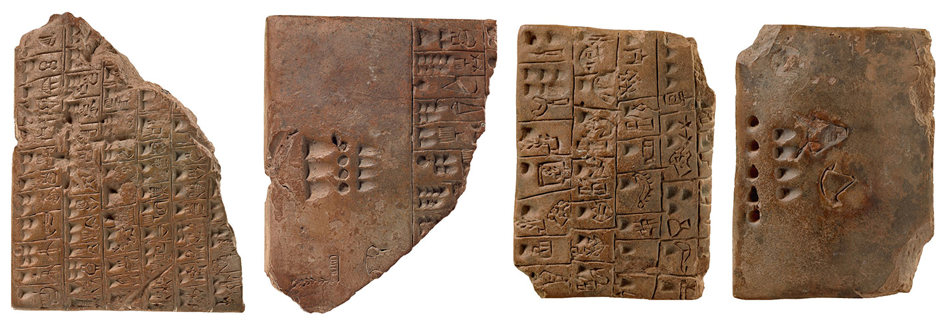
Early tablets from Uruk
Eanna precinct
Cuneiform writing
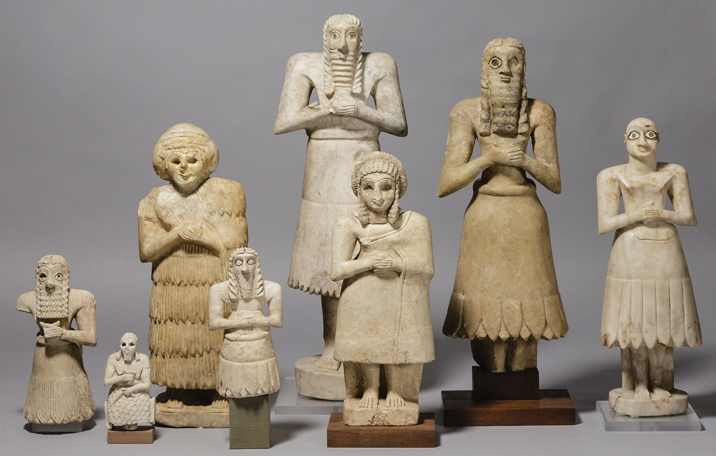
Votive figures from the Temple of Abu, Iraq
2750–2600 BCE
Gypsum, limestone, and alabaster with eyes inlaid with shell, black limestone, and lapis lazuli, largest figure height
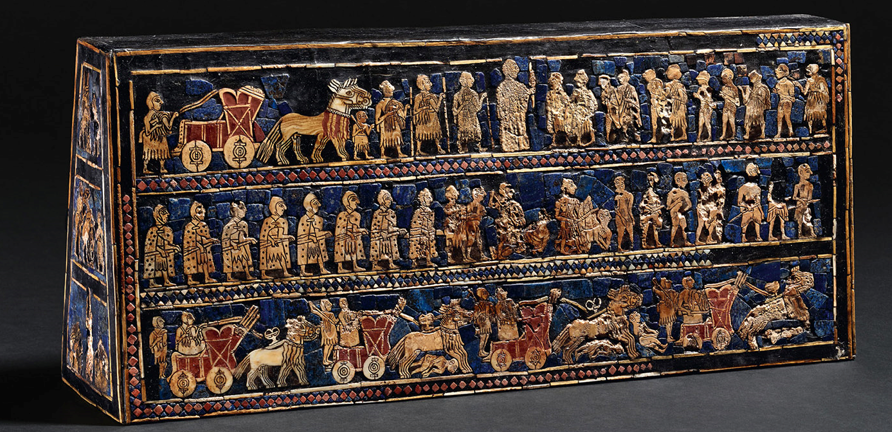
Royal Standard of Ur, battle side
Tomb 779, Royal Tombs of Ur (Iraq)
Early Dynastic IIIA period, 2550–2400 BCE
Wood inlaid with shell, lapis lazuli, red limestone, and bitumen
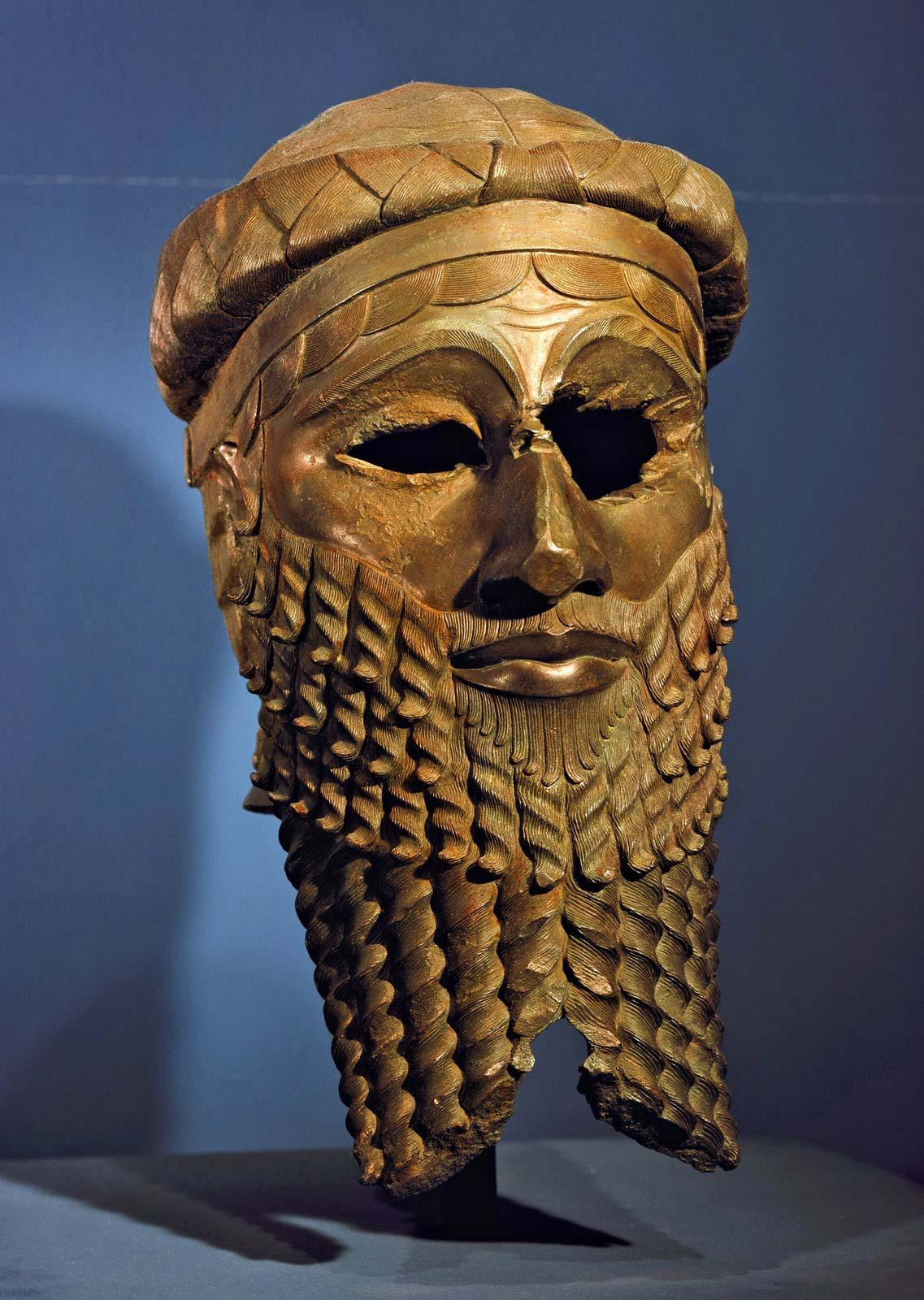
Head of an Akkadian ruler, temple of Ishtar, Iraq
Akkadian period, c. 2250–2220 BCE
Copper alloy
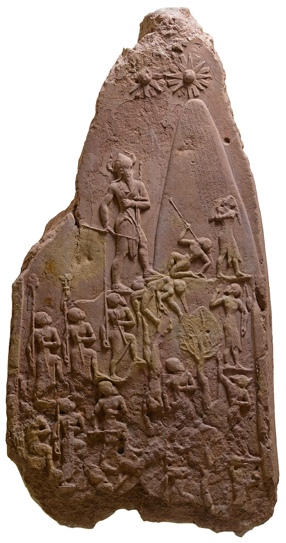
Stele of Naram-Sin, Susa, Iran
Akkadian period, 2254–2218 BCE
Limestone
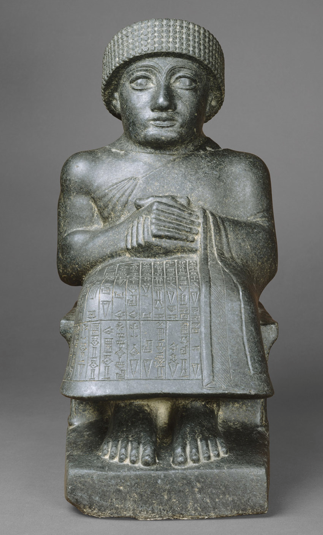
Seated statue of Gudea, Iraq
c. 2120 BCE
Ruler of Lagash. Dedicated to the god Ningishzida
Diorit

Law stele of Hammurabi
c. 1760 BCE
Originally installed in Babylon but excavated at Susa (Iran)
Black basalt
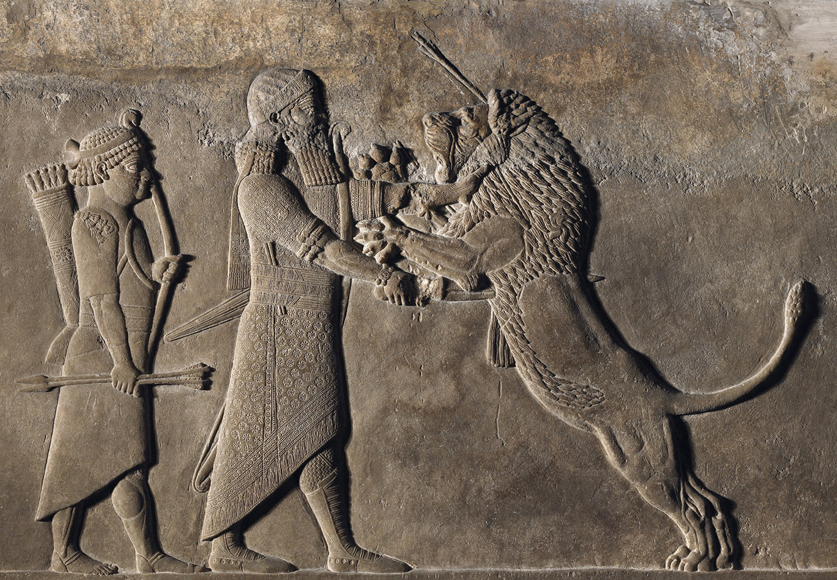
Lion hunt of King Ashurbanipal, North Palace, Iraq
c. 645–635 BCE
Scene from gypsum relief orthostat
Limestone relief
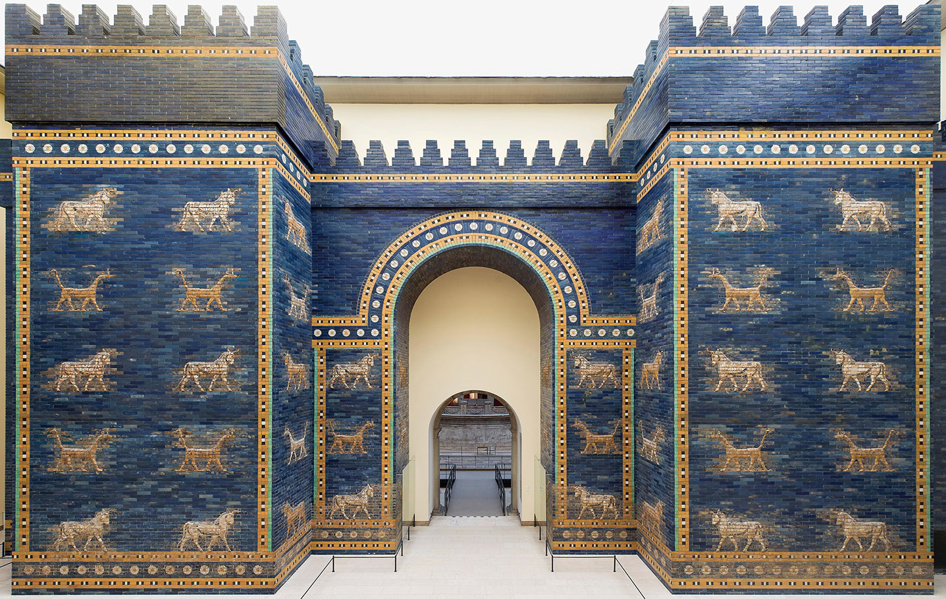
Ishtar Gate of Babylon, Iraq
605–562 BCE
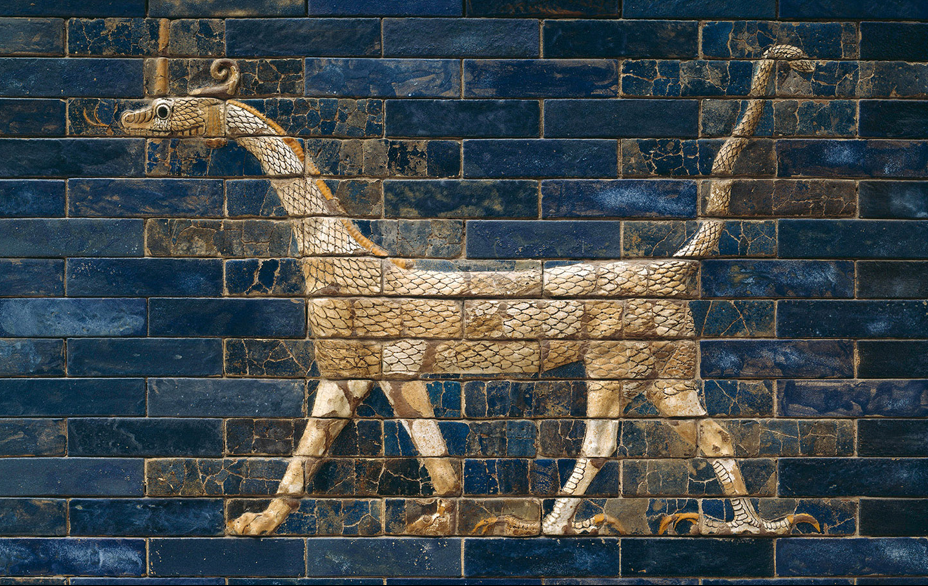
Snake-dragon (mušhuššu) on the Ishtar Gate of Babylon
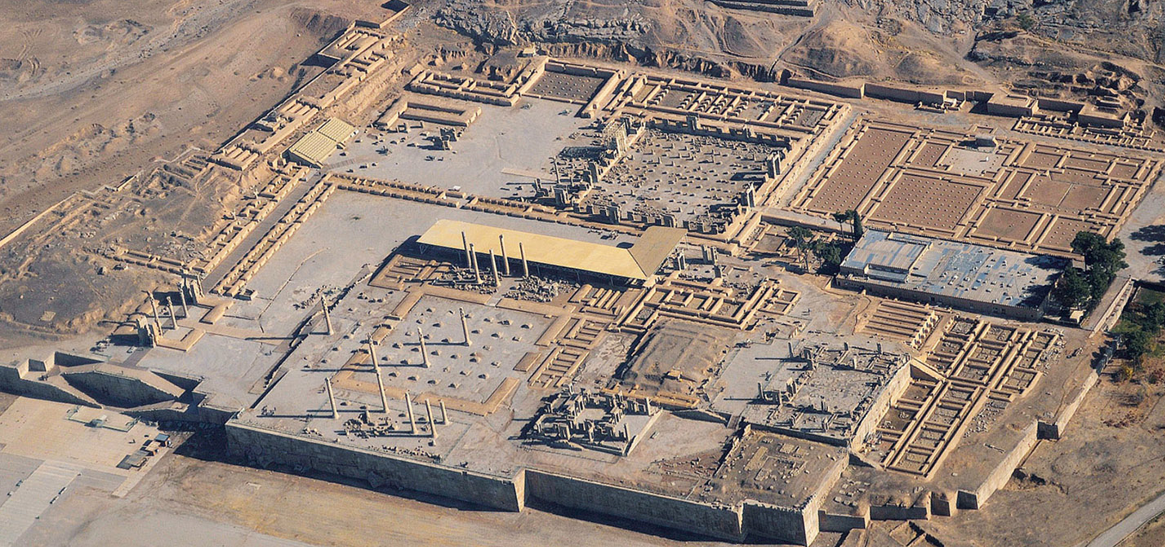
Aerial view of the remains of Persepolis capital city of the Achaemenid Persian empire. Fars province, Iran.
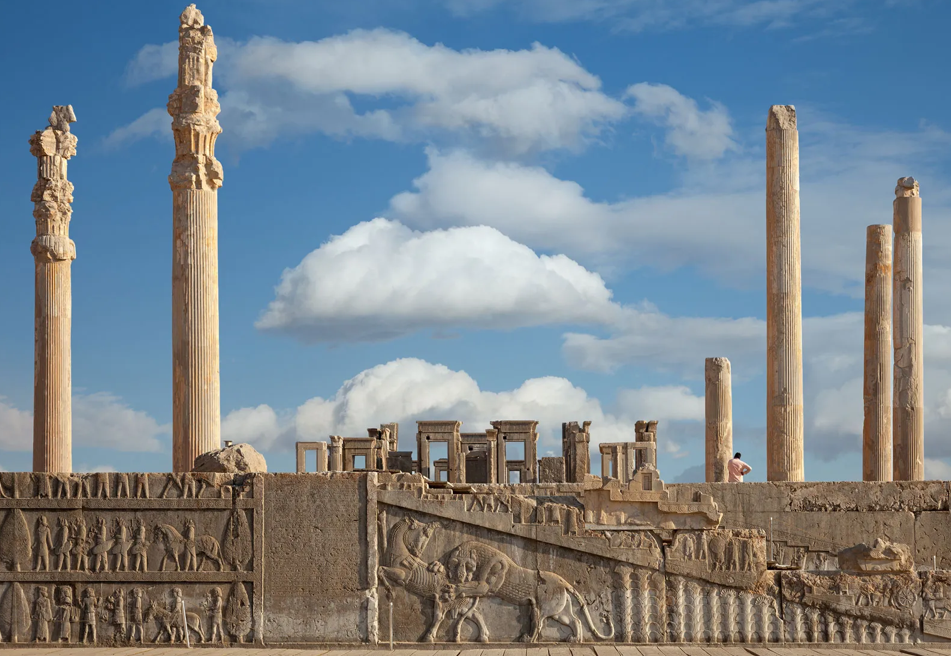
Persepolis capital city of the Achaemenid Persian empire. Fars province, Iran.
Stone reliefs on Apadana building
Ziggurat
A stepped pyramid or tower-like structure in a Mesopotamian temple complex
Façade
Any exterior vertical face of a building, usually the front
Votive
An image or object created as a devotional offering to a deity
Abstract formalism
An approach to art in which forms are made abstract by simplifying their shapes and structures
Libation
The ritual pouring of a liquid, often alcohol, to a spirit or deity as an offering while prayers are said
Inlay
Decoration embedded into the surface of a base material
Hierarchical scale
The use of size to denote the relative importance of subjects in an artwork
Lost-wax casting
A method of creating metal sculpture in which a clay mold surrounds a wax model and is then fired. When the wax melts away, molten metal is poured in to fill the space.
Low-relief (aka bas relief)
Raised forms that project only slightly from a flat background
Archaizing
The use of forms dating to the past and associated with a golden age
Hypostyle hall
A large room with rows of columns or pillars supporting the roof
Capital
The distinct top section, usually decorative, of a column or pillar
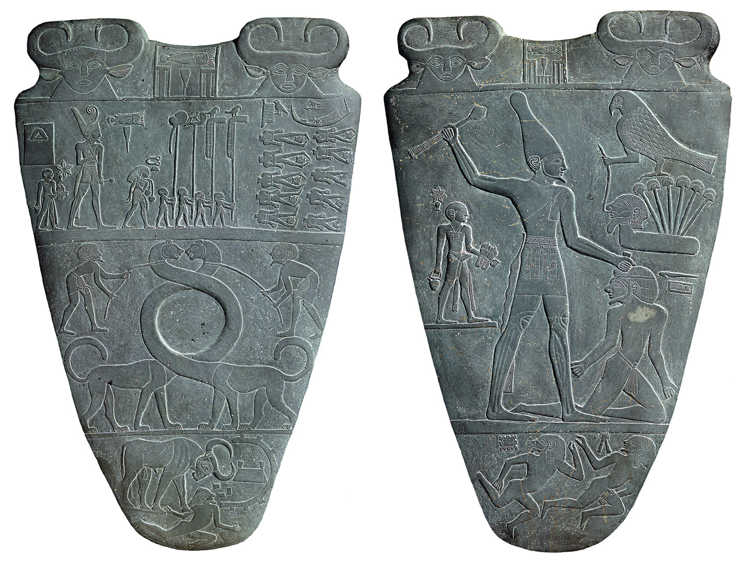
Narmer Palette
Excavated at the sacred enclosure of Horus, Hierakonpolis, Egypt, Dynasty 0, c. 3000 BCE
Graywacke
•Left: Hathor=protector, Narmer’s name in hieroglyphics. Red crown=Lower Egypt, bull attacks fortress.
•Right: King’s name in top middle, sandal bearer on left, Crown of Upper Egypt, sacred ground below, Horus+falcon of underworld, papyrus of Lower Egypt.
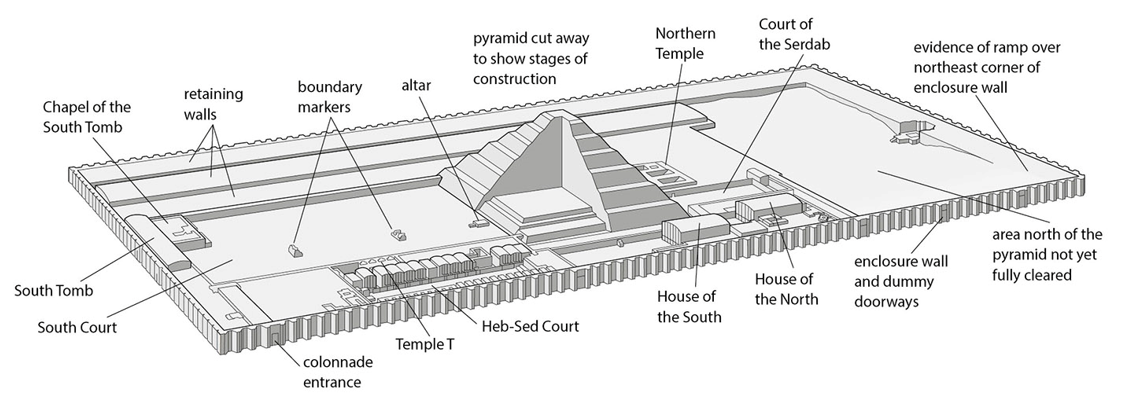
Djoser’s funerary complex, Saqqara, Egypt
Old Kingdom 2667–2648 BCE
Step Pyramid Third Dynasty
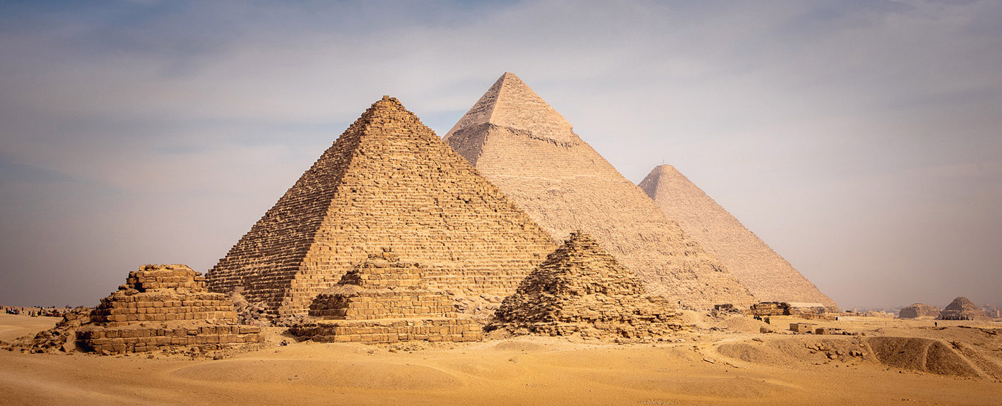
Pyramids on the Giza plateau, Egypt
The pyramid of Khufu is in the foreground; the Great Pyramid of Khafre is in the center; Menkaure’s is on the right, in the background
Old Kingdom, Fourth Dynasty, 2589–2503 BCE
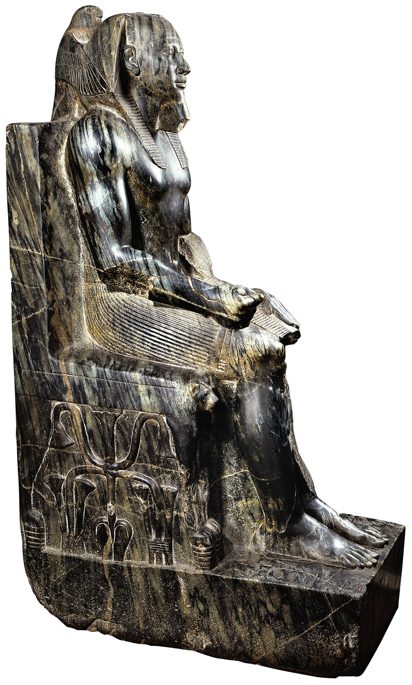
Khafre as the enthroned king
Old Kingdom, Fourth Dynasty, 2558–2532 BCE
Anorthosite gneiss
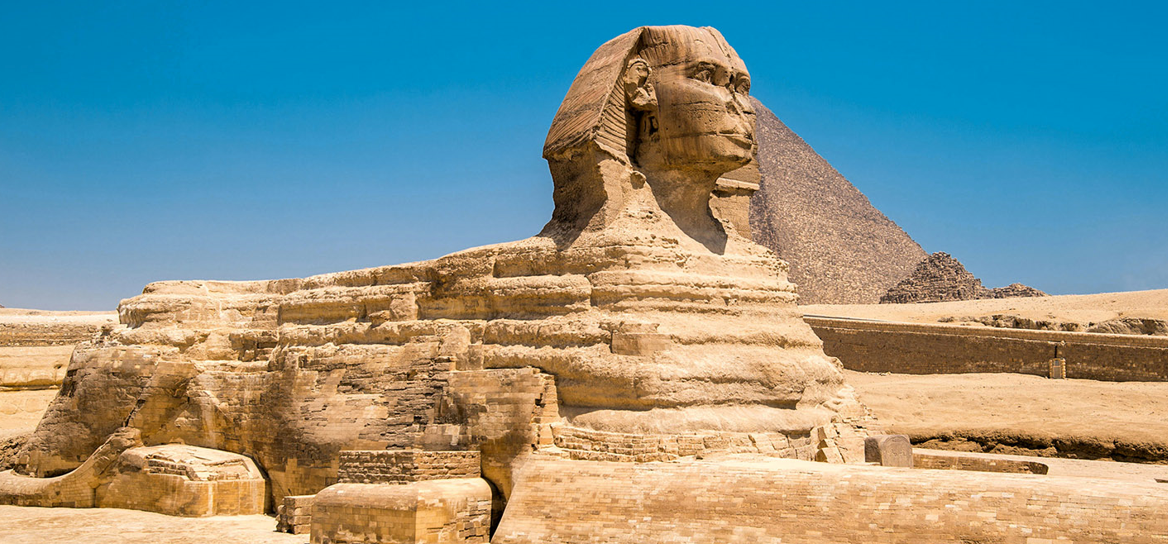
The Great Sphinx, Giza, Egypt
2558–2532 BCE
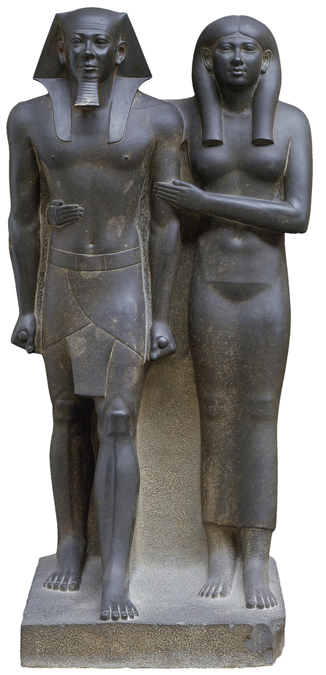
King Menkaure and queen Khamerernebty II. Giza, Egypt
Old Kingdom, Fourth Dynasty, (2532–2503 BCE)
Graywacke with traces of red and black pigment
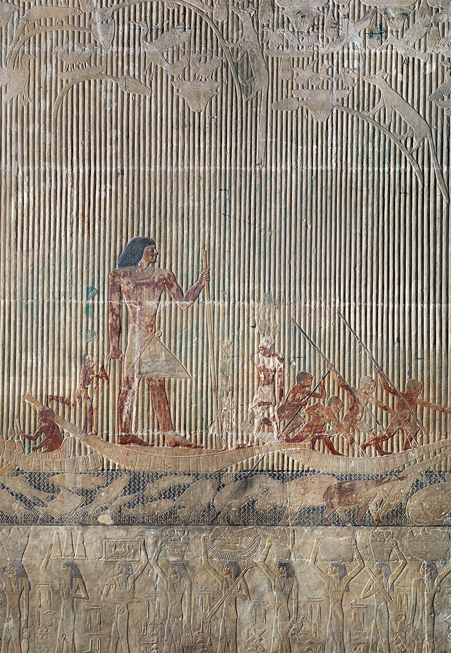
Ti watching a hippopotamus hunt, Tomb of Ti, Saqqara, Egypt
Old Kingdom, Fifth Dynasty, c. 2494–2345 BCE
Painted limestone relief
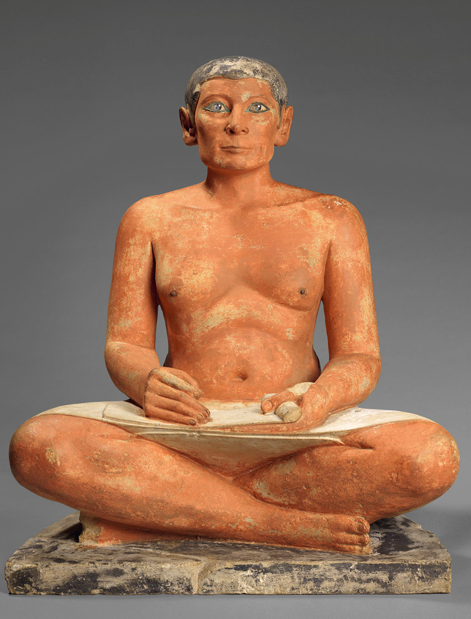
Seated scribe, Saqqara, Egypt
Old Kingdom, Fifth Dynasty, 2494–2345 BCE
Painted limestone, with inlaid eyes of rock crystal, and magnesite mounted in copper
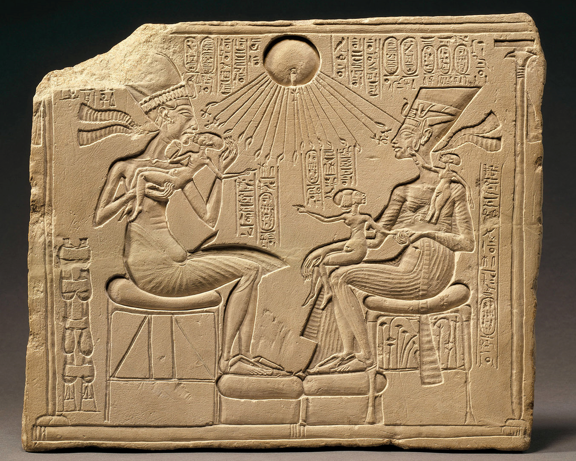
Stele of Akhenaten, Nefertiti, and their children, Akhetaten, Egypt
Eighteenth Dynasty, 1352–1336 BCE
Limestone with painted sunken relief
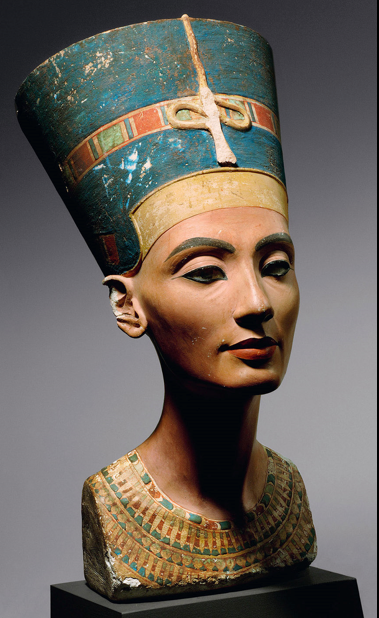
Bust of Nefertiti, from Akhetaten (Tell el-Amarna, Egypt)
Eighteenth Dynasty, 1352–1336 BCE
Painted limestone with gypsum plaster layers
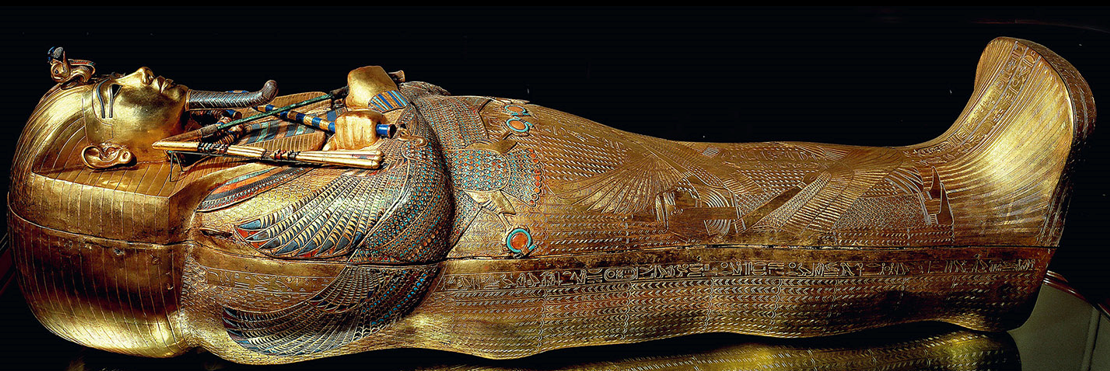
Inner coffin of Tutankhamun (King Tut)
from his tomb in the Valley of the Kings
Eighteenth Dynasty, c. 1327 BCE
Solid gold with inlaid colored ceramics and semi-precious stones
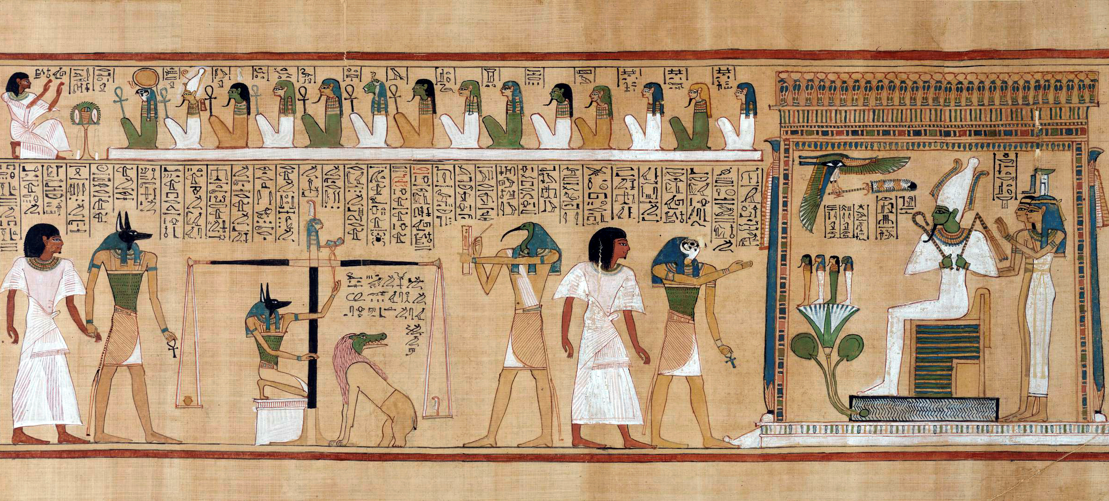
Last Judgment before Osiris, Book of the Dead
c. 1275 B.C.E
Painted papyrus
Hieroglyph
Type of written script that uses conventionalized signs to represent concepts, sounds, or words
Mastaba
A massive, flat-topped rectangular tomb building with slanted side walls; built of either mud brick or cut stone.
Step pyramid
A monumental stone pyramid built using stacked platforms or steps
Corbeling
An overlapping arrangement of wood, stone, or brick wall projections arranged so that each course extends farther from the wall than the course below
Stele
A carved stone slab that is placed upright and often features commemorative imagery and/or inscriptions
Sunken relief
Relief that is carved into a sunken area and does not project above the surface
Bust
A sculpture of a person’s head, shoulders, and chest
Sarcophagus
A container for human remains
Faience
A glassy substance that is formed and fired like ceramic, made by combining crushed quartz, sandstone, or sand with natron or plant ash
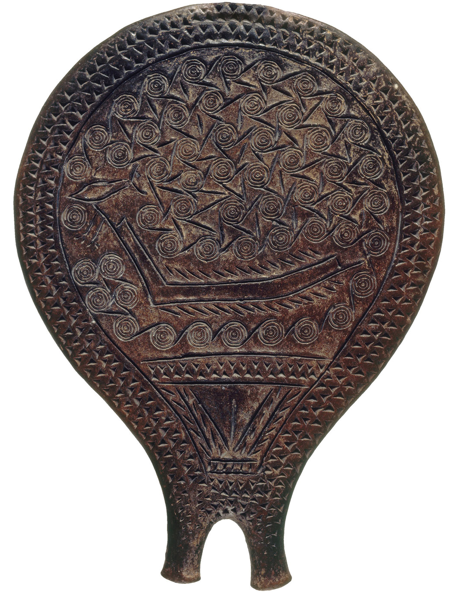
“Frying pan” from Chalandriani, Syros, Greece
Early Cycladic, c. 2500–2200 BCE
Terra-cotta
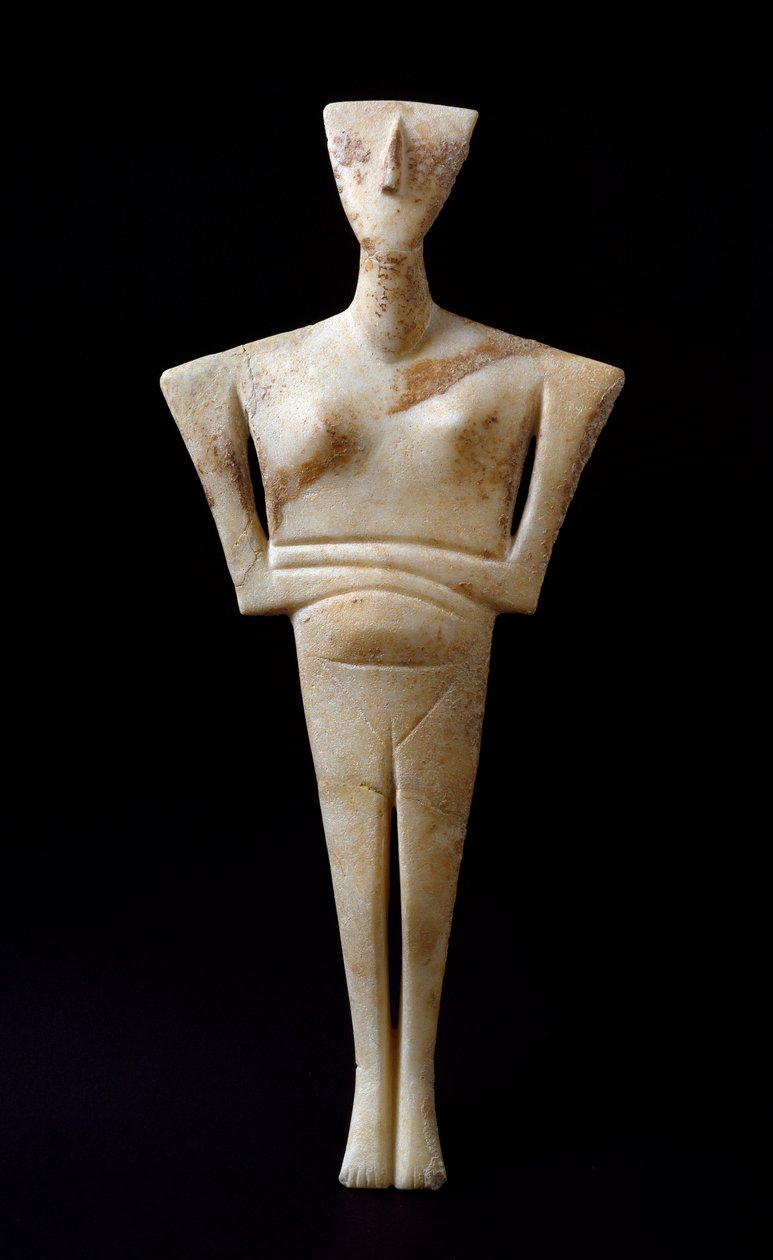
Figure of a woman, from a grave on Syros, Greece
Early Cycladic, c. 2600–2300 BCE
Marble
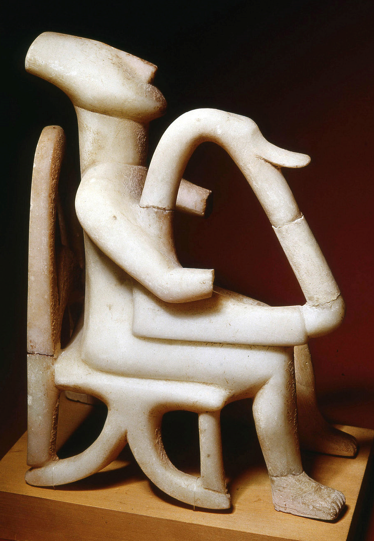
Harp player, Keros, Greece
Early Cycladic, c. 2600–2300 BCE
Marble
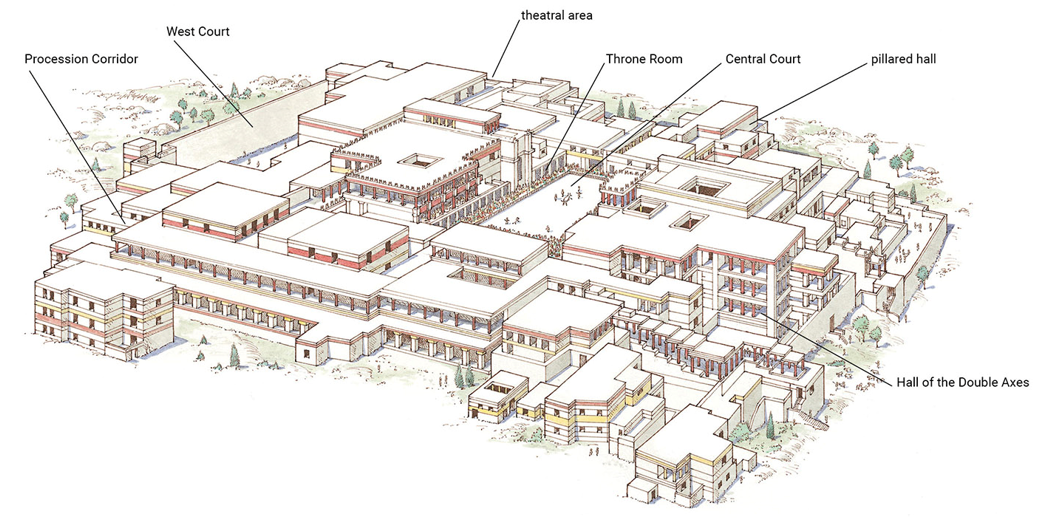
The palace at Knossos, Crete
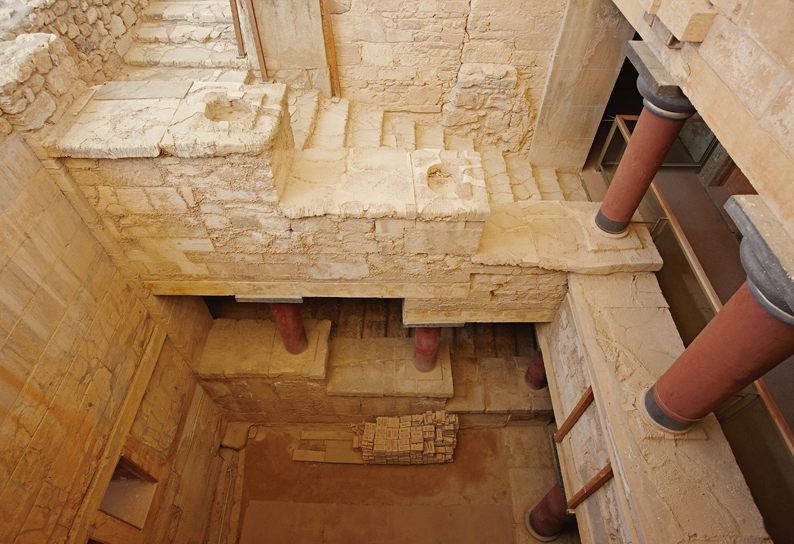
Light well in the palace at Knossos, Crete, Greece
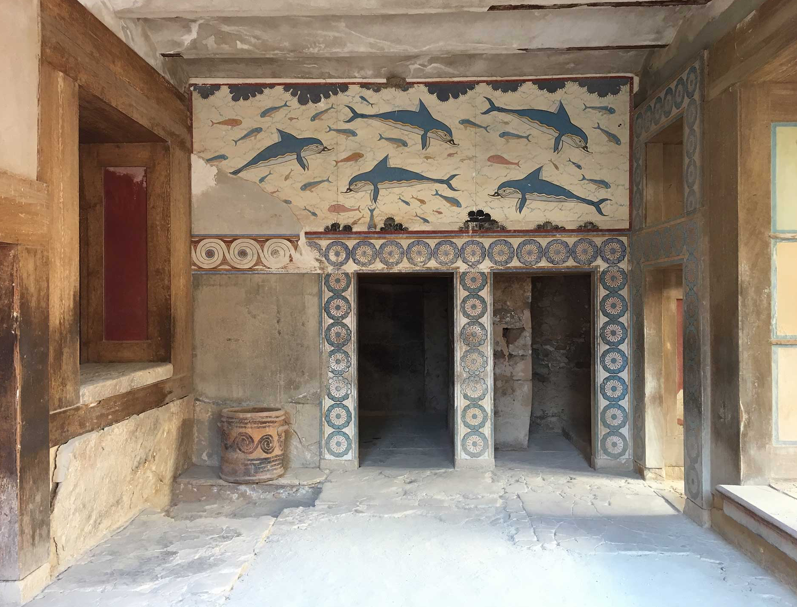
Mural in the palace at Knossos, Crete, Greece
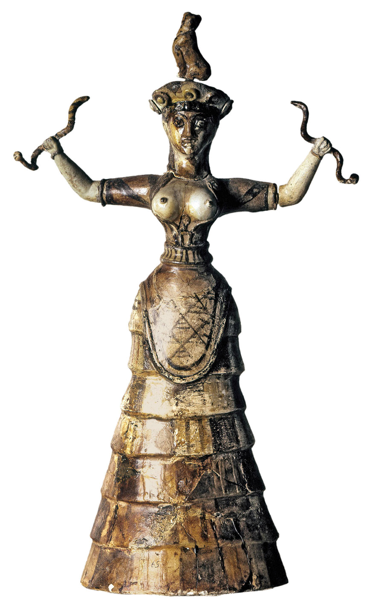
Snake goddess, from the palace at Knossos, Crete, Greece
c. 1600 BCE
Faience
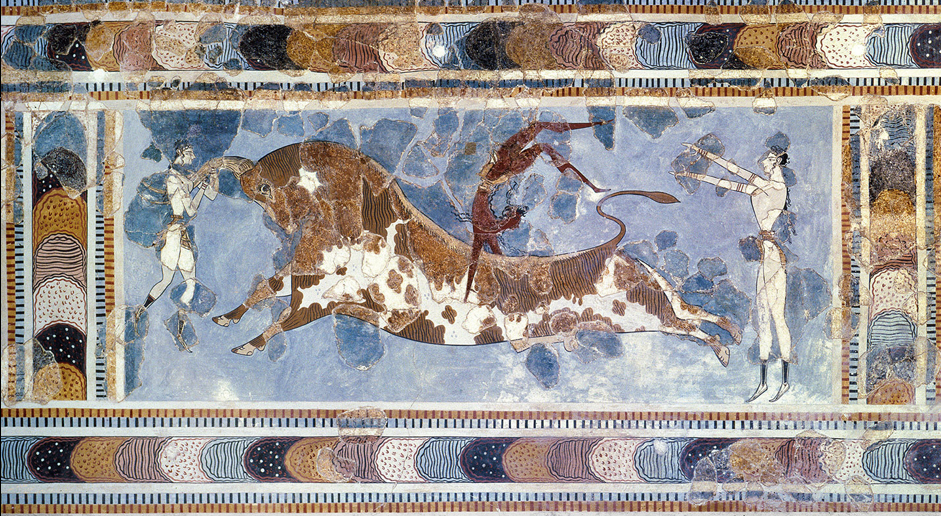
Toreador fresco from the palace at Knossos, Crete, Greece
c. 1400 BCE
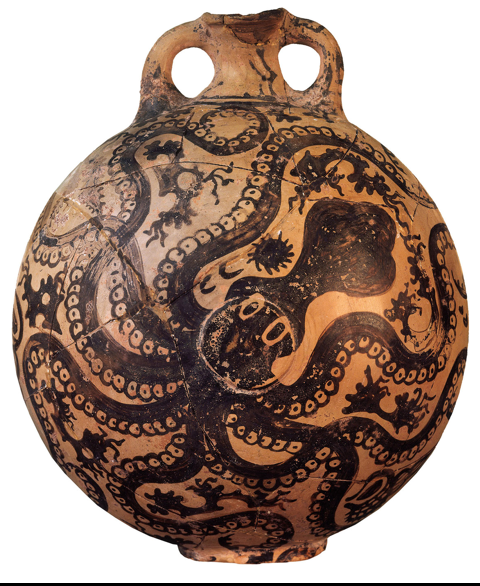
Marine Style octopus flask from Palaikastro, Crete, Greece Neopalatial period, c. 1500–1450 BCE
Ceramic

Flotilla fresco, Room 5, West House, Akrotiri, Thera (Santorini, Greece)
New Palace period, c. 1600 BCE
Fresco
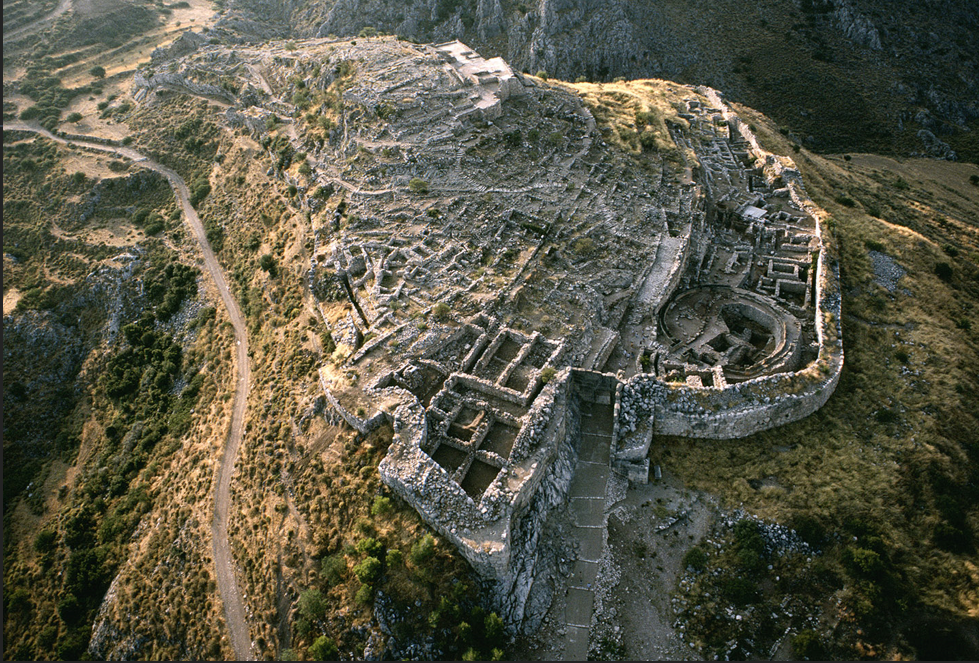
Aerial View of Citadel of Mycenae, Greece
1600–1100 BCE
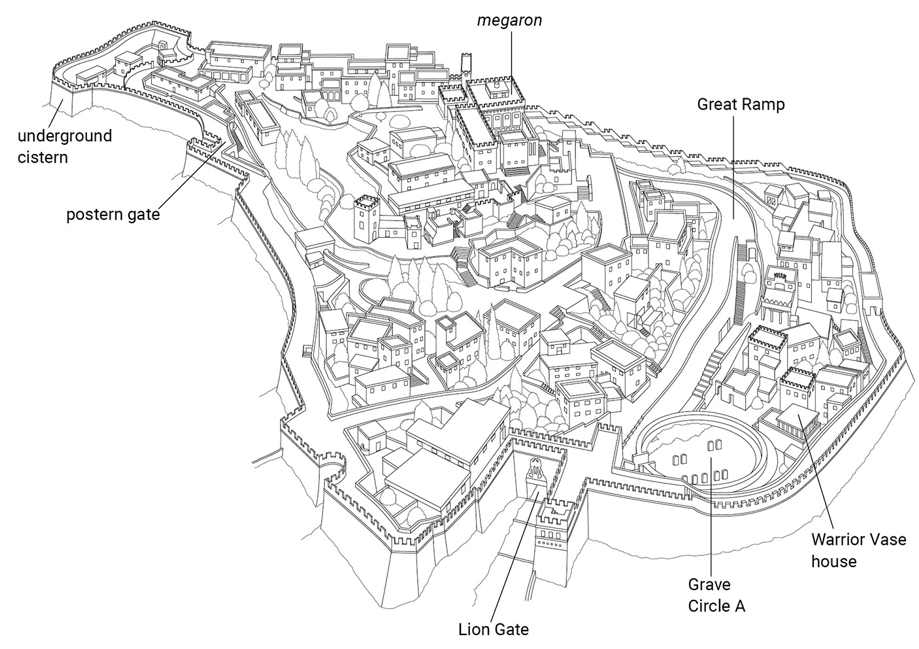
Citadel of Mycenae (reconstruction drawing), Greece
1600–1100 BCE
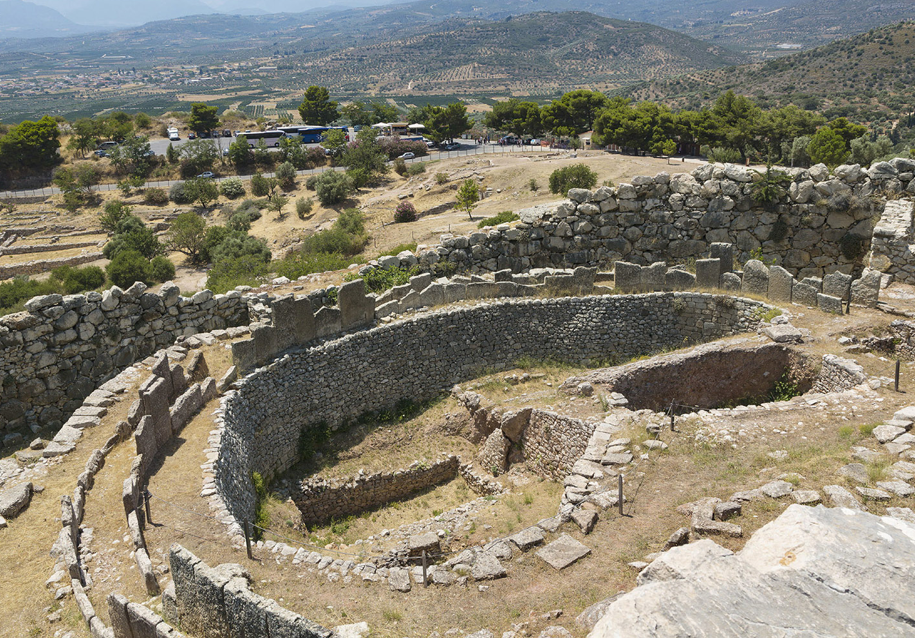
Grave Circle A, Mycenae, Greece
Sixteenth century BCE
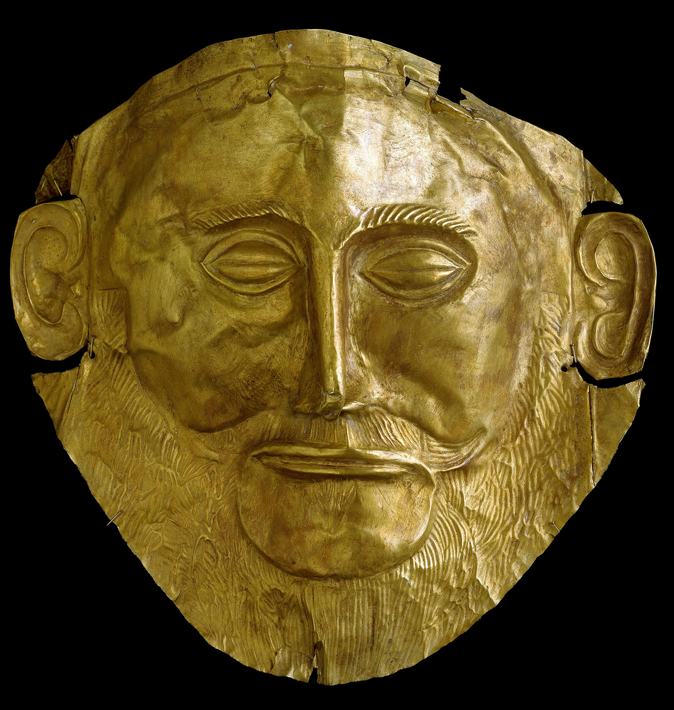
Gold death mask (“Mask of Agamemnon”), from Grave Circle A, Mycenae, Greece
c. 1550–1500 BCE
Gold

Lion hunt dagger blade, from Shaft Grave IV, Grave Circle A, Mycenae, Greece
Sixteenth century BCE
Gold and silver inlaid with bands of niello
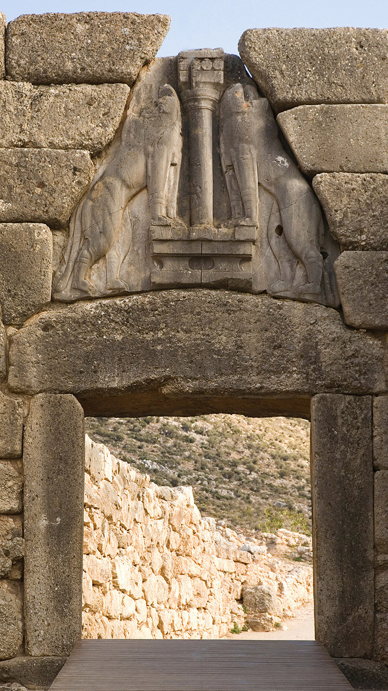
Lion Gate, Mycenae, Greece
Thirteenth century BCE
Limestone relief and Cyclopean masonry
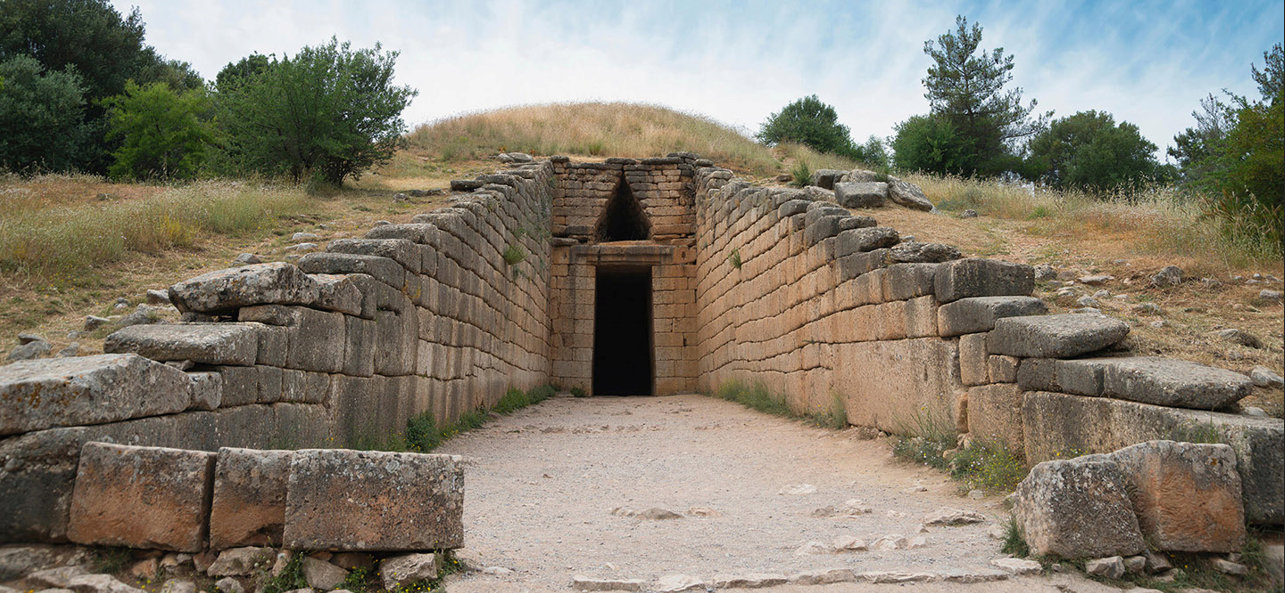
Exterior of Treasury of Atreus tholos tomb, Mycenae, Greece, c. 1300–1250 BCE
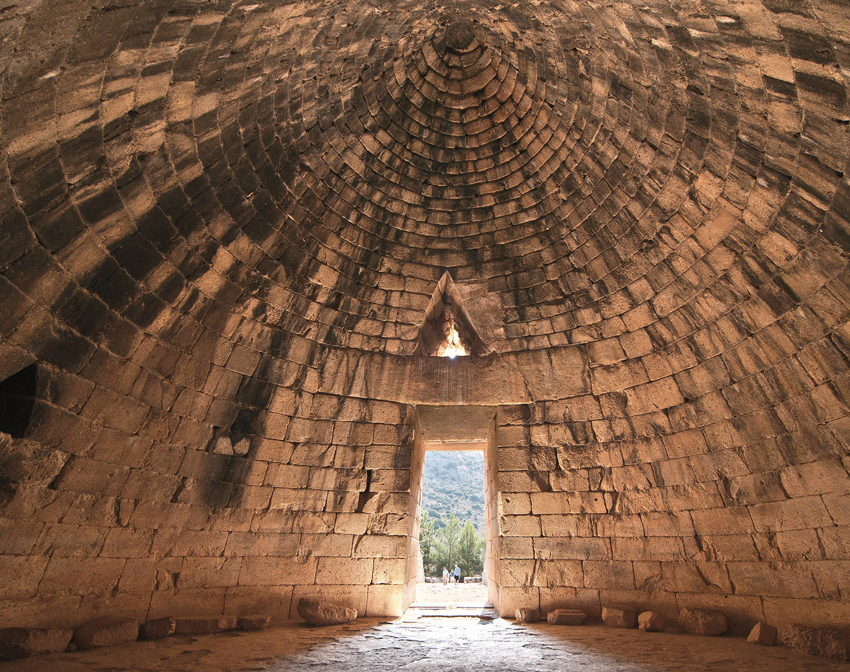
Interior of Treasury of Atreus tholos tomb, Mycenae, Greece, c. 1300–1250 BCE.
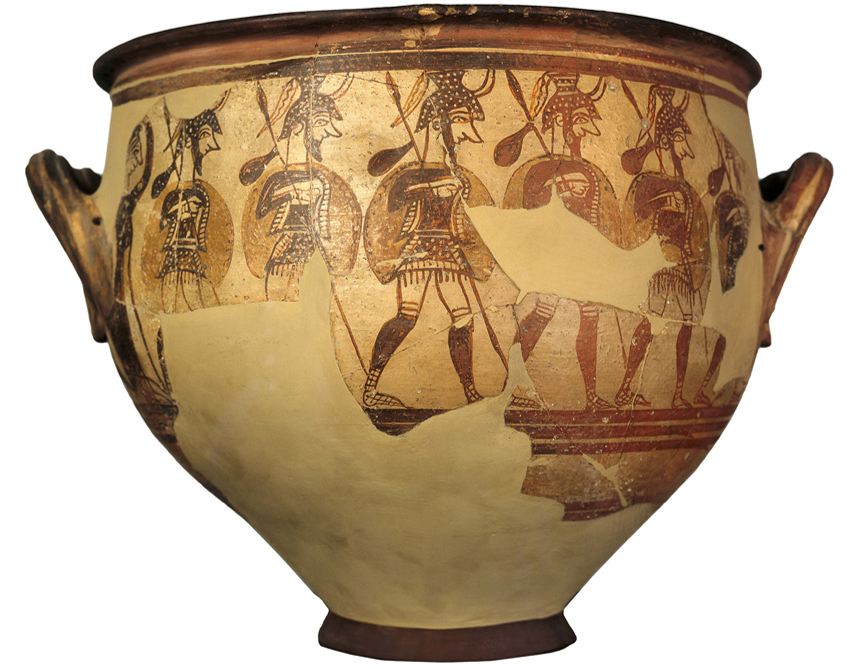
Warrior Vase (krater), from Mycenae, Greece
c. 1300 BCE
Terra-cotta
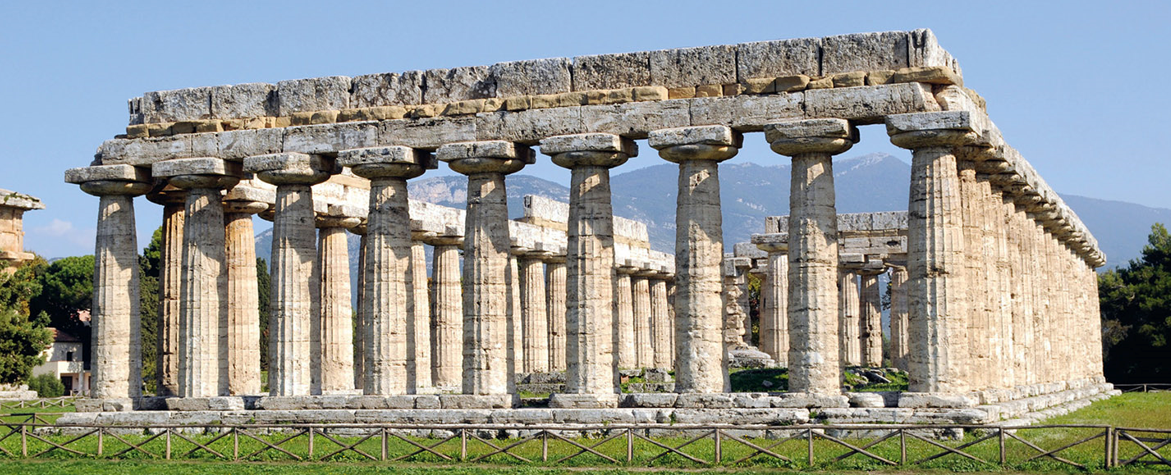
Temple of Hera I, Poseidonia (Paestum), Italy
c. 550 BCE
Limestone covered in plaster
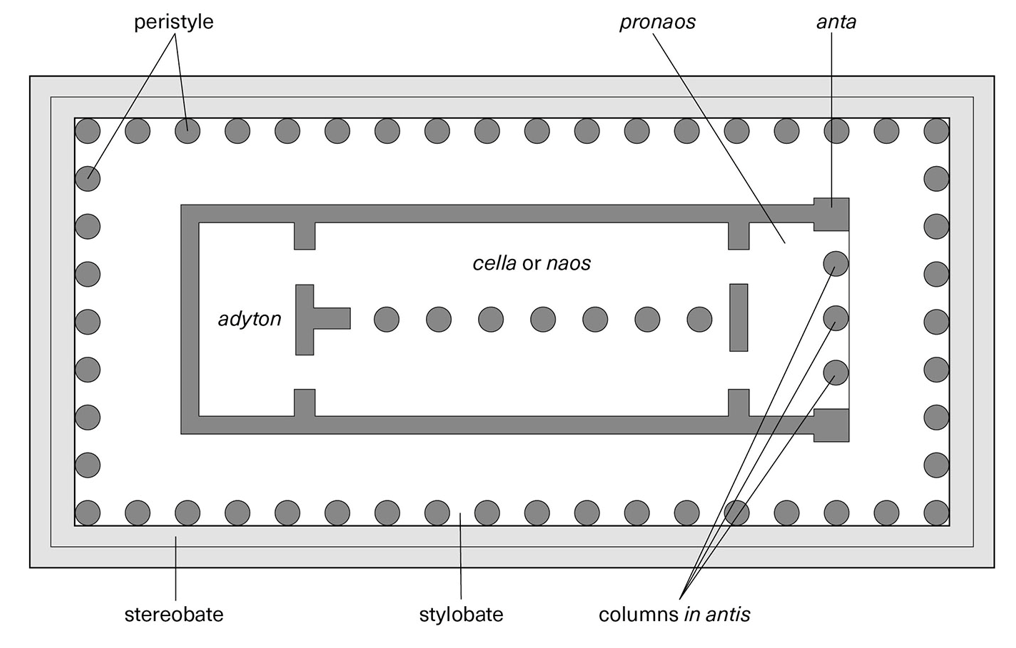
Temple of Hera I, plan drawing, Poseidonia (Paestum), Italy.
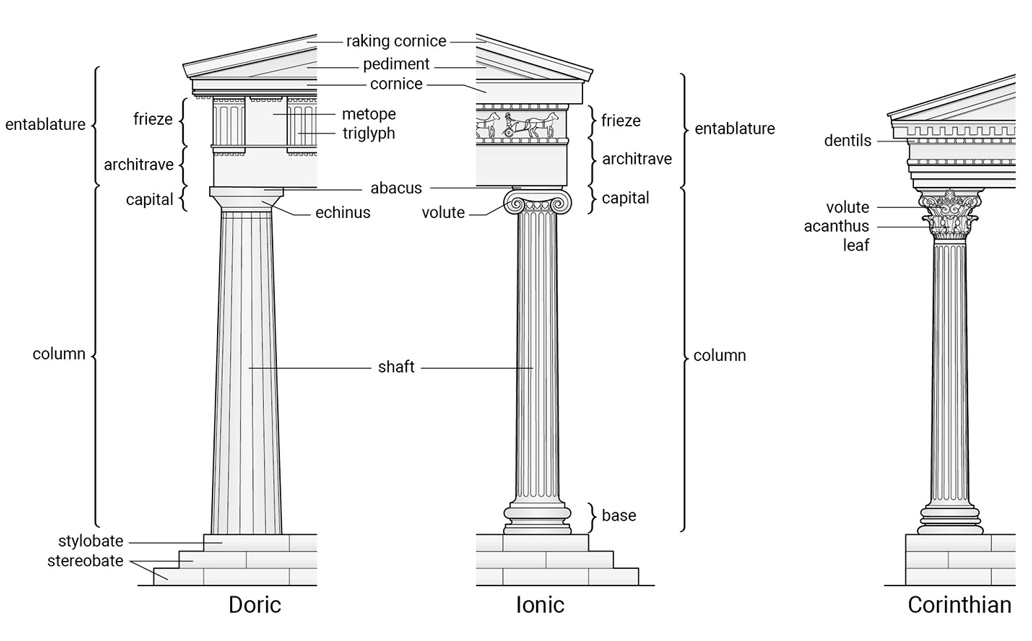
The Classical architectural orders: (left to right) Doric, Ionic, and Corinthian

Peplos Kore Akropolis, Athens
c. 530 BCE
Marble with traces of original paint
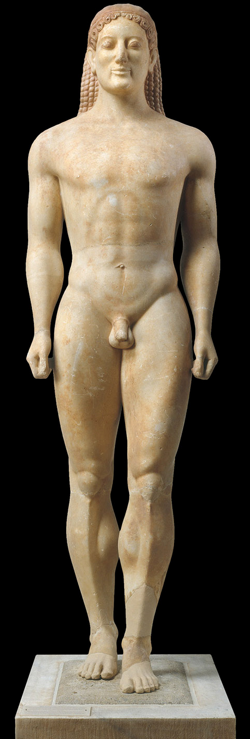
Kouros from Anavysos, Attica, Greece
c. 530 BCE
Marble

Kritios Boy, from the Akropolis, Athens, c. 480 BCE. Marble
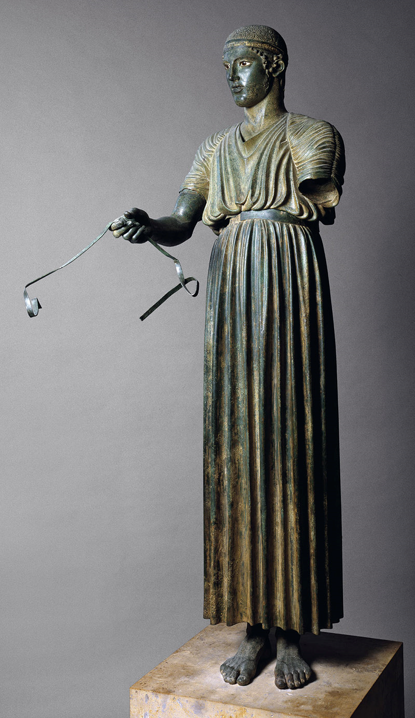
Charioteer of Delphi, Sanctuary of Apollo, Delphi, Greece, c. 478–474 BCE. Bronze with silver, glass, and copper inlay
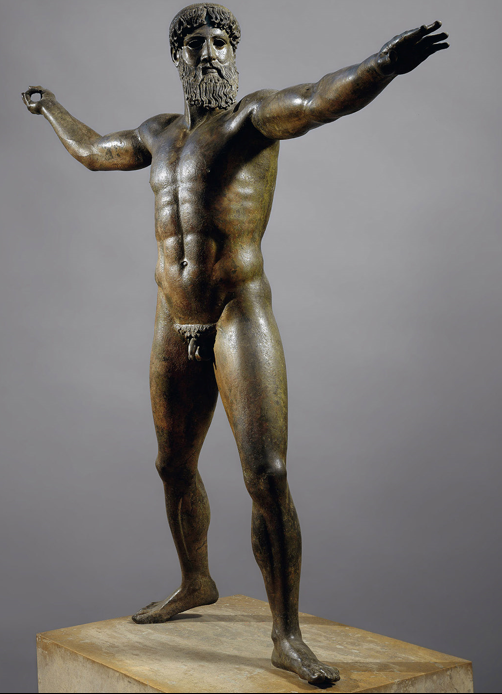
Zeus in Warrior Pose, found off Cape Artemision, Greece, c. 460–450 BCE. Bronze
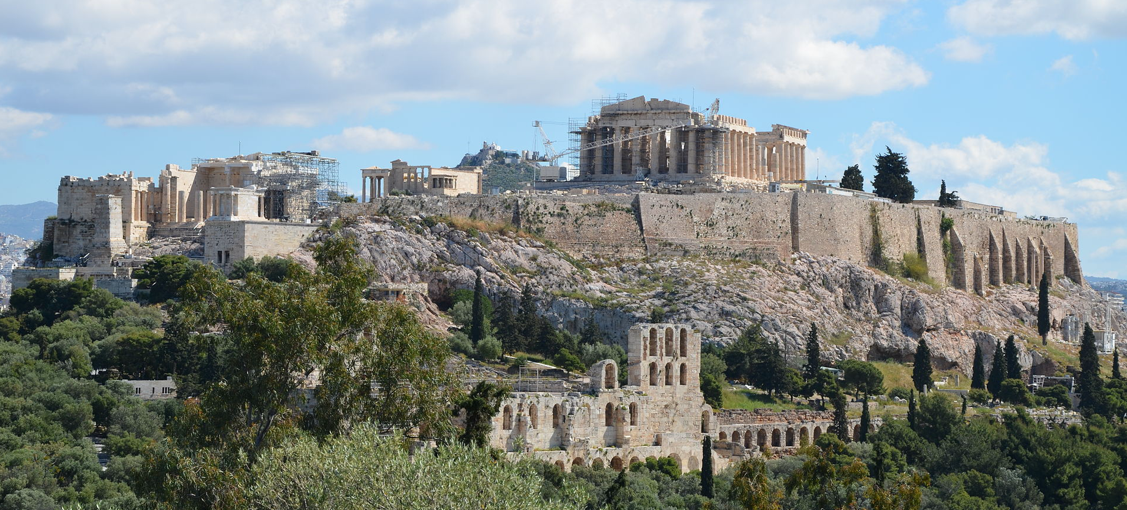
Aerial view of the Akropolis